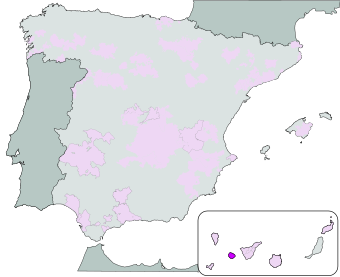La Gomera (DO) facts for kids
| Wine region | |

La Gomera DOP in the province of Santa Cruz de Tenerife in the region of the Canary Islands
|
|
| Official name | D.O.P. La Gomera |
|---|---|
| Type | Denominación de Origen Protegida (DOP) |
| Year established | 2009 |
| Country | Spain |
| No. of vineyards | 125 hectares (309 acres) |
| No. of wineries | 17 |
| Wine produced | 469 hectolitres |
| Comments | Data for 2016 / 2017 |
La Gomera is a special area in Spain known for its wines. It has a label called "Denominación de Origen Protegida" (DOP). This means "Protected Designation of Origin." It's a special quality mark that shows the wine comes from this specific island. The La Gomera DOP covers the entire island of La Gomera. This island is part of the Canary Islands in Spain. The DOP was officially recognized in 2009. It includes six towns: San Sebastián de la Gomera, Hermigua, Agulo, Vallehermoso, Valle Gran Rey and Alajeró.
Island Climate and Geography
La Gomera is a very mountainous island. Growing grapevines here is quite hard work. The island's steep slopes make it difficult to plant and care for the vines. To help with this, farmers build stone walls to create flat areas called terraces. These terraces help hold the soil and make it possible to grow grapes on the hillsides.
Traditionally, grapevines on La Gomera were left to grow along the ground. However, many farmers now use a method called "trellising." This means the vines are trained to grow along wires or frames. This method helps the grapes get more sunlight and air. It also makes it easier to harvest them.
Vineyards and Wineries
As of 2015, about 125 hectares (which is about 309 acres) of land on La Gomera are used for growing grapes. These vineyards are officially registered with the group that manages the DOP. There are around 150 grape growers on the island. Also, seven wineries are registered to produce wine under the La Gomera DOP label.
Approved Grape Varieties
To make wine under the La Gomera DOP, winemakers must use specific types of grapes. These are called "authorised grape varieties." The rules also control how many vines can be planted in one area. They also set limits on how much grape juice can be taken from the grapes.
The approved grape varieties include:
- Red grapes: Castellana Negra, Listán Negro, Malvasía Rosada, Negramoll, Listán Prieto, Tintilla, Bastardo Negro, Cabernet Sauvignon, Pinot Noir, Ruby Cabernet, Syrah, Tempranillo, Vijariego Negro, Merlot, Moscatel Negro
- White grapes: Albillo, Bermejuela, Forastera Blanca, Gual, Doradilla, Malvasía Volcánica, Malvasía Aromática, Moscatel de Alejandría, Sabro, Verdello, Vijariego, Breval, Listán Blanco, Pedro Ximénez, Bastardo Blanco, Torrontés
The Regulatory Council is the group that makes sure all the rules are followed. They also control other important things for wine quality:
- Maximum planting density: This means how many grapevines can be planted in one area. For La Gomera DOP, it's 4,000 vines per hectare.
- Maximum must yield: "Must" is the fresh grape juice before it becomes wine. This rule limits how much juice can be extracted from the grapes. For La Gomera DOP, it's 70%. This helps ensure the quality of the juice.
See also
 In Spanish: La Gomera (vino) para niños
In Spanish: La Gomera (vino) para niños

